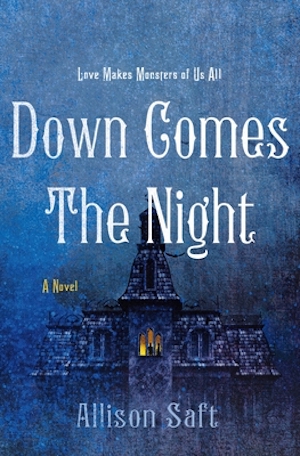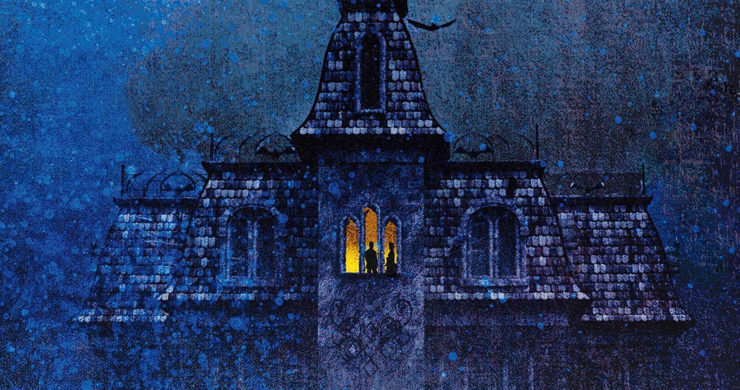Villains institutionalizing heroines, crumbling, sentient houses, and a decadent social scene with a festering core: the Gothic is back in young adult fantasy, and with book deals slated into 2022, it shows no signs of going anywhere. It’s tempting, I think, to explain this Gothic resurgence as a symptom of YA fantasy leaning Darker & Edgier. The aesthetic conventions of the genre—crumbling manors, flickering candelabras, and brooding lords—certainly lend themselves well to that end. But this explanation hardly gets to the bottom of things.
The question still remains: why has this set of images become so alluring to us? Why this 18th- and 19th-century form, and why does it so capture the hearts of 21st-century readers? Given my own role in perpetuating the Gothic trend, I’ve wrestled with these questions for the better part of a year. I believe that to understand the genre’s popularity now, we need to understand first what it is—as well as the historical and economic conditions that led to its popularity throughout the 19th century.
What best characterizes the Victorian Gothic, I would argue, are not its visual trappings but its fixation on money and financial schemes. We need only look to a few examples to see the pattern. In Wilkie Collins’ The Woman in White (1859), the definitely-not-evil Baronet of Blackwater, Sir Percival Glyde, conspires to marry a young woman, then institutionalize her, so that he can steal her fortune. After Heathcliff from Emily Brontë’s Wuthering Heights (1847) acquires his wealth through means unknown, he systematically exacts his vengeance on his enemies through a series of marriages, wardships, and property acquisitions. Even Bram Stoker’s Dracula (1897) opens with a solicitor’s visit to the vampire’s castle, and indeed, Dracula’s nefarious plan and ultimate demise hinges on his… very robust real estate portfolio. We might wonder why so many Gothic villains are running side gigs, but the reality is they had to.
The popularity of the 19th-century Gothic novel rose alongside industrial capitalism. Once, the British peerage and landed gentry could make the bulk of their income by renting out their landholdings. But as the bourgeoisie consolidated power at the end of the 18th century; heavier taxes were levied on inherited wealth; and the value of agricultural land and grain prices fell in the wake of the Homestead Act, the landed gentry found themselves tethered to estates that were no longer profitable, much less self-sustaining. Generously, we could say the Industrial Revolution allowed for class mobility. In truth, however, it caused an economic and social freefall that left everyone scrabbling for a new class position, including the nobility.
We can see this dynamic play out in Guillermo del Toro’s cannily anachronistic film Crimson Peak (2015). Once comfortable as a member of the landed gentry, Sir Thomas Sharpe now wears threadbare, outdated clothing and struggles to secure investors for his clay-mining operation. Participating in his sister’s elaborate schemes—marrying and murdering young heiresses for their money—doesn’t cut it anymore in the year 1901. Instead, he must reinvest his stolen fortunes into his business while his estate literally sinks into the very clay he hopes to mine for profit. Crimson Peak perfectly captures the heart of the Victorian Gothic by dramatizing the tension between emergent and residual economic forms and literalizing the decay of the landed gentry class. No Gothic heroine can truly hope for a better life with a nobleman when he’s even broker than she is—and the hope may cost her life.
And yet, few of them can resist the magnetic but worn grandeur of the Gothic manor and the seduction of its proprietor. In their 2011 book Cruel Optimism, Lauren Berlant describes the friction in this affect: oftentimes, we find that “something [we] desire is actually an obstacle to [our] flourishing.” We’re haunted by fantasies of what she calls “the good life,” even if our circumstances will never allow us to attain them. Today, young readers and authors are facing even more tumultuous economic conditions than our 19th-century counterparts, and I have to wonder how many of us have even this poisonous brand of optimism. We live in a moment seemingly defined by financial uncertainty, where the promises of upward mobility, retirement, homeownership, and even basic job security have shattered. Here in the States, our government has failed to care for us—and actively kills its most vulnerable citizens with police brutality and its fumbled, callous response to COVID-19. In January, our collective faithlessness in the American Dream drove thousands of retail investors to gamble their savings on a GameStop short squeeze, if only to see hedge fund billionaires bleed a drop for their role in the 2008 financial collapse.
In other words, our dreams of the Good Life have begun to show fault lines too deep to ignore. The impact is so widespread, I’d be remiss if I didn’t acknowledge that the Gothic is enjoying newfound life beyond YA fantasy. It’s also trending in the adult space, most notably in works by authors of color. Silvia Moreno-Garcia’s New York Times bestselling Mexican Gothic (2020) is about a young woman who investigates her cousin’s mysterious husband, who almost certainly married her for her money. It’s a book about the legacy of colonialism—from High Place’s silver mine to the sci-fi twist to the casual remark on page 18 about how the villain “brought European earth here” (which is very Dracula; there’s almost certainly a bloodsucking metaphor to made here). Meanwhile, Elisabeth Thomas’ Catherine House (2020) significantly features a mostly non-white cast who must survive the sinister eponymous boarding school. Catherine House recruits and entraps the most economically and emotionally precarious people by selling them the promise of the Good Life: once they graduate, they’ll have guaranteed success and infinite opportunity. The school’s controversial New Materials program—which studies plasm, a substance like the alchemical prima materia—specifically recruits people they consider “disposable,” like our protagonist Ines.
Buy the Book


Down Comes the Night
The Gothic across genres and age categories is almost always an exploration of power imbalances on the axes of class, race, and gender. However, what makes YA fantasy particularly intriguing to me is that, when compared to the “healthier” adult fiction market, it’s a genre that’s in itself precarious. The YA book publishing industry has begun to crack under the weight of our current economic reality. If you participate at all in online YA publishing spaces, you’ve likely seen many a grim proclamation that YA fantasy is dead. Sometimes, it’s hard to believe otherwise. We’re inundated with terrible news: the market is saturated, editors and agents have increasingly selective lists, the midlist is vanishing, advances are smaller (especially for marginalized writers), YA imprints are shuttering, and big publishing houses are consuming one another. Many writers are understandably worried about their future in the industry when it seems that the bubble is, at last, bursting.
This may sound like a bleak assessment, but I want to offer a more hopeful reading. Although the figurative belt has tightened, YA fantasy will never die—not as long as there are people to breathe new life into it. The Gothic re-emerges in moments of economic upheaval, but more importantly, it re-emerges when we know the old world is rotten but the new one hasn’t appeared just yet. YA fantasy is a category in flux, and it’s certainly experiencing growing pains. But what remains constant is perhaps a counterintuitive truth: both Gothic and YA fantasy are genres characterized by hope.
Margaret Rogerson’s Sorcery of Thorns (2019) brilliantly illustrates the tension between new and old, darkness and light. In Rogerson’s world, magic is class-coded. It’s transactional and contractual: sorcerers strike bargains with demons in order to gain power. More importantly, in this modernizing Victorian-flavored city, magic still carries the trappings of old-world nobility. Sorcerers are “titled” in that they’re called Magister and inherit the true name of the demon bound to their family—“like heirlooms,” the love interest quips. Should someone stumble upon the true name of a highborn demon, they must keep the demon in the family for a few generations to earn the respect of the so-called “old houses.” To often-hilarious effect, Silas, the demon bound to the love interest, takes the form of a dutiful valet; however, the narrative often makes us sit with the questionable ethics summoning and binding demons to servitude.
Rogerson’s sophomore novel is by turns thoughtful, whimsical, and tear-jerking—and always aware of its Gothic undertones. [Spoilers follow.] In the final scene of the novel, the protagonist Elisabeth holds what she calls “a wake”—Gothically complete with a summoning circle and eerily flickering candles—for Silas, who was banished to the Otherworld after he sacrificed himself for her. She mourns him, until she remembers: “The version of him that had won out hadn’t been Silariathas, ruthless and cold. It had been his other side that had fought and emerged victorious, proven true. What if… what if?” In the final paragraph, Elisabeth attempts to summon Silas not with his true name—Silariathas—as is tradition, but with his ‘human’ name. The candles snuff out, ominous but triumphant. In this ambiguous closing image, we’re left with the impression that a cycle has been broken. With death, a new possibility for magic has opened: perhaps Elisabeth can treat a demon as an equal and a friend, not a servant. Magic no longer must be rooted in exploitation and economic power.
While Sorcery of Thorns leans more whimsical, even the darkest Gothic classics end with a glimmer of light. Painfully insular and sharply emotional, Wuthering Heights enacts a cycle of vengeance and entrapment, down to an eerie shortage of names. Cathy Earnshaw becomes Cathy Linton, who gives birth to Cathy Linton who becomes Cathy Heathcliff who plans to become a new Cathy Earnshaw. But by the last page, as in Sorcery of Thorns, there’s a wrench in this despair-inducing repetition. Haunted by the ghost of Cathy Linton, Heathcliff dies—and with the cycle broken, the course of young Cathy and Hareton’s lives is no longer over-determined. They can begin anew. If you’ll allow me a Frankenstein metaphor, the Gothic serves as an imaginative laboratory: a space where writers can rearrange a limited set of social and stylistic elements into new shapes. It’s an incredibly powerful narrative form, especially when Gothic protagonists are often young women—and now, increasingly women of color and/or queer women. The Gothic gives us the tools to change traditional narratives in horror, ones that so often doom us to death. By staging and breaking cycles of horror, we can dream up new possibilities and better ways forward.
As YA undergoes the difficult transformation into a more stable and sustainable category, many authors have returned to the Gothic to imagine stability during uncertain times. In 2021, I think we’re all in search of ways to make sense of our “crisis-ordinary,” to borrow another of Berlant’s terms. When we exist in a world where fear is pervasive, crises are unremarkable, and just-getting-by is our new everyday, finding meaning in this terrifying mundanity becomes necessary to our survival. When we reach for scripts and templates to talk about our experiences—and search for ways to navigate our current economic freefall—there are few better places to look than stories about worlds far more fantastical than our own.
Allison Saft is the author of Down Comes the Night and other eerie romantic tales. After receiving her MA in English Literature from Tulane University, she moved from the Gulf Coast to the West Coast, where she spends her time hiking the redwoods and practicing aerial silks.










